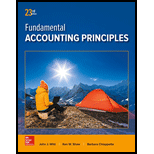
Revenue Expenditure:
Revenue expenditures costs are everyday expenses incurred to run organizational operations and other usual business activities. They are expenses related to current year of the business and are recognized in the as soon as they are paid. It includes insurance expenses, repair and maintenance expenses.
Capital Expenditure:
Capital expenditures are expenses which are added to the cost of fixed assets and include expenses incurred to bring the fixed asset in working state. These expenses increase the value of the fixed asset and have a benefit to business for more than one accounting period. For example installation expenses, delivery expenses, any expenses which increases the useful life of fixed assets.
1.
To identify: Categorization of expenses as RE or CE.
To prepare: Journal entries.
Want to see the full answer?
Check out a sample textbook solution
Chapter 10 Solutions
Fundamental Accounting Principles
- Aihua Manufacturing Inc. has two divisions. Division A has a profit of $225,000 on sales of $4,500,000. Division B is only able to make $78,000 on sales of $650,000. Based on the profit margins (returns on sales), which division is superior?arrow_forwardCan you help me solve this financial accounting question using valid financial accounting techniques?arrow_forwardCan you solve this general accounting question with the appropriate accounting analysis techniques?arrow_forward
- Gibson Inc. has provided the following data for the month of December. The balance in the Finished Goods inventory account at the beginning of the month was $94,200 and at the end of the month was $89,750. The cost of goods manufactured for the month was $412,800. The actual manufacturing overhead cost incurred was $142,300 and the manufacturing overhead cost applied to jobs was $148,500. The adjusted cost of goods sold that would appear on the income statement for December is __. Provide answerarrow_forwardMichael Jones's capital statement reveals that his drawings during the year were $55,000. He made an additional capital investment of $35,000, and his share of the net income for the year was $28,000. His ending capital balance was $240,000. What was Michael Jones's beginning capital balance? a. $232,000 b. $202,000 c. $162,000 d. $202,000arrow_forwardWhat will net income be?arrow_forward
- Eric Industries' break-even point in units is 2,500. The sales price per unit is $35, and the variable cost per unit is $25. If the company sells 6,800 units, what will net income be?arrow_forwardCan you help me solve this general accounting question using valid accounting techniques?arrow_forwardLumo Co had the following transactions in 2020arrow_forward
- Nordica Chemicals produces joint products M and N from Compound Z in a single operation. 800 liters of Compound Z, costing $2,400, produce 500 liters of Product M, selling for $3.50 per liter, and 300 liters of Product N, selling for $6.00 per liter. The portion of the $2,400 cost that should be allocated to Product M using the value basis of allocation is____.arrow_forwardI need help solving this financial accounting question with the proper methodology.arrow_forward5 PTSarrow_forward

 AccountingAccountingISBN:9781337272094Author:WARREN, Carl S., Reeve, James M., Duchac, Jonathan E.Publisher:Cengage Learning,
AccountingAccountingISBN:9781337272094Author:WARREN, Carl S., Reeve, James M., Duchac, Jonathan E.Publisher:Cengage Learning, Accounting Information SystemsAccountingISBN:9781337619202Author:Hall, James A.Publisher:Cengage Learning,
Accounting Information SystemsAccountingISBN:9781337619202Author:Hall, James A.Publisher:Cengage Learning, Horngren's Cost Accounting: A Managerial Emphasis...AccountingISBN:9780134475585Author:Srikant M. Datar, Madhav V. RajanPublisher:PEARSON
Horngren's Cost Accounting: A Managerial Emphasis...AccountingISBN:9780134475585Author:Srikant M. Datar, Madhav V. RajanPublisher:PEARSON Intermediate AccountingAccountingISBN:9781259722660Author:J. David Spiceland, Mark W. Nelson, Wayne M ThomasPublisher:McGraw-Hill Education
Intermediate AccountingAccountingISBN:9781259722660Author:J. David Spiceland, Mark W. Nelson, Wayne M ThomasPublisher:McGraw-Hill Education Financial and Managerial AccountingAccountingISBN:9781259726705Author:John J Wild, Ken W. Shaw, Barbara Chiappetta Fundamental Accounting PrinciplesPublisher:McGraw-Hill Education
Financial and Managerial AccountingAccountingISBN:9781259726705Author:John J Wild, Ken W. Shaw, Barbara Chiappetta Fundamental Accounting PrinciplesPublisher:McGraw-Hill Education





